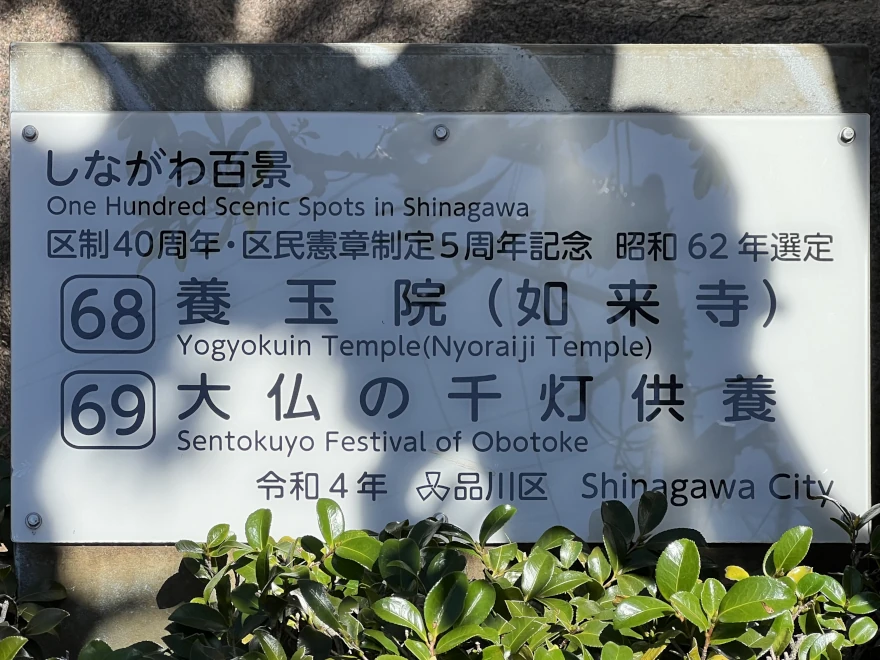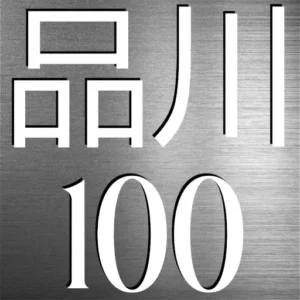🪷 Yōgyokuin Nyorai-ji – Where Statues Whisper of Survival
Overlooking the cityscape from a gentle hill in Nishi-Ōi, Yōgyokuin Nyorai-ji Temple (養玉院如来寺) is a spiritual landmark known for its seated statues of the Five Wisdom Buddhas. Visible from the Tokaidō Shinkansen, the temple is often called “Ōi’s Great Buddha” (Oi no Obotoke – 大井の大仏) and remains a tranquil oasis in modern Tokyo.
This temple has a tangled and fascinating past rooted in Edo-period resilience, tragedy, and spiritual reinvention. What stands today is the result of two separate religious lineages, one founded by a Tendai abbot with deep ties to the Tokugawa shogunate, the other—if oral tradition is to be believed—by a secret Christian convert who survived mass execution and transformed his salvation into sculpture.
🕰 Timeline – The Two Temples Become One
- 1619 (Genna 5): During the height of the Tokugawa shogunate’s crackdown on Christianity, over 60 kakure kirishitan (Hidden Christians) are executed by crucifixion at Shinagawa Beach. One man, reportedly named Mataemon (also known as Matashichi or Yatashichi), miraculously survives. Believing this to be divine providence, he escapes to Kazusa Province and undergoes a deep spiritual transformation.
- 1636 (Kan’ei 13): The survivor, now calling himself Mokujiki Tanshō (Buttshō, 但唱), becomes a mokujiki hijiri—an itinerant ascetic who eats no grain and sculpts wooden Buddhas. He, and his disciples, carve five massive seated Buddha statues representing the Five Wisdom Buddhas (Gochi Nyorai) in Takanawa, near Sengaku-ji. This becomes the foundation of the original Nyorai-ji Temple, locally known as “Shiba Daibutsu.”
- 1663 (Kanbun 3): In a separate development, the sub-temple Sanmyōin, affiliated with Kan’ei-ji in Ueno and founded by the monk Kenkai (a disciple of the powerful abbot Tenkai), is renamed Yōgyokuin. The renaming honors Lady Yōgyokuin (posthumous name of Lady Ofuku), the wife of Sō Yoshizane, 2nd Daimyō of Tsushima. The temple becomes the clan’s bodaiji (family temple) and gains official patronage from the Tokugawa family.
- Mid-1600s: The priest Nenkai (念海), a disciple of Kenkai and second-generation abbot of the temple then known as Sanmyōin (later Yōgyokuin), plays a key role in the temple’s growth and its establishment as the family temple of the Tsushima Sō clan. He is later commemorated with a seated wooden statue (1671) by sculptor Chōgorō, which survives to this day.
- 1746 (Enkyō 3): After a major fire during the Kyōhō era destroyed most of the original statues, the Five Wisdom Buddhas are re-carved. These are the statues that survive today, housed in the current main hall. Despite reconstruction, they retain spiritual continuity with the original vision of Mokujiki Tanshō.
- 1908 (Meiji 41): The original Nyorai-ji in Takanawa relocates to Nishi-Ōi, Shinagawa Ward, as part of urban modernization efforts. The site retains its identity as the guardian of the Five Wisdom Buddhas and continues to attract pilgrims and worshippers under the new moniker “Ōi Daibutsu.”
- 1923 (Taishō 12): The Yōgyokuin temple (formerly Sanmyōin), located in Ueno’s Sakamoto area, merges with Nyorai-ji after the Great Kantō Earthquake devastates its buildings. The united temple becomes Yōgyokuin Nyorai-ji and inherits the histories, artifacts, and patronage of both lines.
- 1942 (Shōwa 17): Under the Religious Organizations Law (Shūkyō Hōjin Hō), all religious institutions are required to formalize their structures and register with the government. Yōgyokuin Nyorai-ji incorporates as a legal religious entity. This legislation enforces state oversight during wartime Japan but also preserves records of temple assets and lineage.
Yōgyokuin Nyorai-ji Today
The temple to serve the Shinagawa community as a site of prayer, reflection, and memory. Visitors come to witness its monumental Buddhas, seasonal festivals, and complex, layered history—encompassing Buddhism, persecution, artistic legacy, and the cultural resilience of Tokyo.
🪶 Hidden Christian Connection – Myth or Memory?
A number of sources—both religious and folkloric—record the story of Buttshō (aka Yatashichi), a former Christian who survived execution in 1619. He supposedly sculpted the Five Wisdom Buddhas as Buddhist stand-ins for the Christian God and four archangels. This theory is supported by patterning on the statues (now lost or replaced) that allegedly resembled crosses, and by their unusual iconography. The temple’s original location in Takanawa overlaps with known kirishitan execution sites, such as Satsunozuka (札の辻), where prominent converts like Hara Mondo were martyred.
Some researchers speculate that Buttshō’s “conversion” may have been pragmatic, allowing him to survive and later express his suppressed faith through esoteric Buddhist imagery. While the current temple officially follows the Tendai school, even today there are reports of Christian visitors who quietly pay respects to the Great Buddha, viewing it as a symbol of hidden faith and endurance.
Yōgyokuin Nyorai-ji Today
In addition to its fascinating past, the temple grounds feature peaceful gardens, seasonal flowers, and quiet pathways. The Sentōkuyō Festival, a 1,000-lantern memorial held annually, adds to the temple’s spiritual significance. Despite its modest appearance from the outside, the temple’s inner hall offers a breathtaking view of the five nearly five-meter-high Buddhas seated in solemn formation.
Yougyokuin Nyorai-ji is both a place of worship and a silent witness to the clash of faiths, the endurance of belief, and the transformation of persecution into peace. Whether visitors come seeking history, beauty, or introspection, this temple offers all three in abundance.
🪨 Yōgyokuin Nyorai-ji’s Sacred Relics and Cultural Assets
- Wooden Statues of the Five Wisdom Buddhas: Current versions likely reconstructed c. 1746 after fires in the 1700s. Dainichi (center), flanked by Shaka, Amida, Hōshō, and Yakushi Nyorai.
- Wooden Seated Statue of Monk Nenkai (念海上人): Sculpted in 1671 by the Buddhist artist Chōgorō; restored in 1825.
- Amida Triad Silk Painting: Muromachi period scroll with Amida, Kannon, and Jizō, classified as a Tangible Cultural Property of Shinagawa Ward.
- Stone-engraved Seated Jizō Bodhisattva: Carved in the Edo period; another local designated cultural asset.
🙏 Temple Notes
- Sect: Tendai (天台宗)
- Principal Deity: Dainichi Nyorai (center), with Shaka, Amida, Hōshō, and Yakushi Nyorai
- Founding: 1636 by Mokujiki Tanshō (Nyorai-ji); Yōgyokuin founded earlier, renamed 1663
- Major Festival: Sentōkuyō (Thousand Lantern Memorial)
- Historic Identity: Former site of Christian martyrdom and Buddhist-Christian syncretism
📍 Visitor Information
Address: 5-22-25 Nishi-Ōi, Shinagawa-ku, Tokyo 140-0015
Hours: 9:00 AM – 4:00 PM (Subject to change)
Best season: Summer for Sentōkuyō, Spring for cherry blossoms
Phone: 03-3771-4816
Parking: Available (10 spaces)
Best season: August 13th for Sentōkuyō, Spring for cherry blossoms
Website: www.yougyokuin.com
Note: Please be respectful when visiting this sacred site. Some visitors interpret its legacy through different spiritual lenses, so reverence is appreciated regardless of belief.
Where is it?
| what3words | ///chart.muddy.discount |
| latitude longitude | 35.597011, 139.717256 |
| Nearest station(s) | Nishi-Ōi Station (Yokosuka and Shonan Shinjuku lines) Magome Station (Asakusa line) |
| Nearest public conveniences | Temple grounds and nearby parks |
Show me a sign.

The Hyakkei sign is located near the temple entrance gate.
Withervee says…
The 5 Buddha might not be as flashy as Kamakura’s — but it has heart, history, and barely any crowds.
Site Character
- Lifestyle 生活 (Seikatsu): ✔️
- Historical Significance 歴史 (Rekishi): ✔️
- Atmosphere/Natural Features 風土 (Fūdo): ✔️
Who in their right mind would vote for this?
- Local (Tendai) Buddhists
- Spiritual pilgrims
- Festivalgoers
- Cultural historians
- Peace seekers
Further reading
The Temple’s Christian Connection – a blogger writes
While you’re there…
Continue your spiritual journey by visiting the Sentōkuyō Festival if it is August 13th or the tomb of Hirobumi Itō if it is early November.

